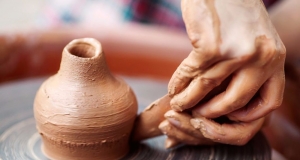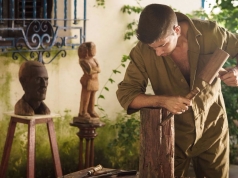Pottery, undertaken by the potter, is the activity of making fired clays. Pottery is made by forming clay into objects of different shapes, then heating the objects in a kiln to very high temperatures. This will remove all of the water from the clay, inducing a reaction that creates a permanent change in the structure of the clay. It increases its strength, sets the shape and hardens the material. It can be decorated before or after firing.
There is a preparation process that clay needs to go through to make it ready to use as air is normally trapped inside the clay and has to be removed.The moisture has to be evenly spread throughout the clay to ensure a quality end result. Once it has been shaped, it needs to be dried and then put into the kiln to be fired. Creating pottery is an ancient art and necessity. Many people find the whole process quite therapeutic, relaxing and creative. You can literally create anything from your lump of clay and decorate it in whichever way your imagination takes you. You can create a pottery business by learning the art, teaching others, making bespoke and/or useful items and much more.
Keep scrolling down the page to learn more about this hobby. HobbyFinda has over 300 exciting hobbies to explore and with the use of our HobbyFinda Calculator, we make it easy for you to find a hobby the fun way!
The Importance Of Clay And Pottery In Children’s Development
By Patty Storms – Lakeside Pottery Ceramic School and Studio, Stamford, CT
In recent years, as budget concerns reduced art programs in schools, there has been a great deal of research about the importance of art in child development. From my own experience as an artist and ceramic teacher, I believe that few art mediums kindle growth and skills in children in the way that clay does. At Lakeside Pottery Ceramic School and Studio in Stamford CT, I have taught children (ages 6 to 15) for the last six years. During that time, I have witnessed firsthand how invaluable the experience of working with clay is for sensory development, motor skills, self esteem, and self expression, problem solving skills, discipline, and pride. Clay also has a uniquely therapeutic quality that I have seen settle and calm children; it retains their attention for hours.
Sensory Development and Motor Skills
There is no better moment for me than witnessing a child’s joy as they sit at the potter’s wheel for the first time and place their wet hands on slowly spinning clay! Clay, and its necessity to be touched, is at once familiar to children. The sensory experiences they encounter in our pottery studio are numerous and as they experience the texture and feel of the clay, the students express what they are sensing with uninhibited enthusiasm; “It’s cold, it’s wet and squishy, and it’s so heavy!” Clay asks to be poked, pinched, twisted and rolled and as they handle it, children develop both fine and major motor skills and realize that they have an effect on the clay as it responds to their manipulation. Children visually inspect the clay’s surface and color, they smell it and they laugh at the sounds it makes when it’s wet. For many, it’s perhaps the first time they’ve been encouraged to get wet and dirty in a classroom environment and there is an instinctive and uplifting response to the freedom they feel. Even when the finished product is ready to take home, the children hold and cradle their work, smoothing their fingers over the now colorfully glazed surface as they turn it around and around for inspection.
Esteem and Expression
From my experience as an art teacher, I believe that clay is a unique art medium because it is highly responsive to touch and very forgiving. As soon as children are given clay, they immediately begin to mold and shape it. They become aware that they are in charge and have influence over the medium as it is quick to respond to their fingers. The feeling that they are in command of the clay gives the students the confidence to attempt any project which opens the door to greater self expression and imagination. Clay also allows a child to learn to repair mistakes and therefore not be afraid to make them. Making mistakes is essential for self improvement but can be difficult and even an obstacle for some children. The forgiving quality of clay, and therefore the ability to readily fix mistakes, gives the child a sense of control over their project’s success which improves self esteem and self expression as they realize that mistakes aren’t going to stop their progress. For example, during a class, a boy had been working on his project, a toothbrush holder that looked like a baseball player, for over two hours. All of a sudden he accidentally pierced a hole right through the side of the project while decorating. He looked up at us devastated. But as I showed him how to take a piece of clay and fill in the damaged area, he suddenly took the clay from my hand and stated, “I can do it myself!” He repaired his piece and went on decorating with fervor.
Problem Solving
Clay is different from other art mediums in that it requires an understanding of the three dimensional world. In our programs, we often encourage the children to work on spinning decorating wheels or to get up from their seats and walk to the other side of the table so they can see their creation from all sides. They begin to understand shape, form, and perspective, and therefore get a first lesson in geometry. The child learns to really look and see the world around them and discovers their place in that world. They gain knowledge of planning methods and problem solving as they map out their three dimensional project. Where should the door go on my square castle? How tall can I make the tree before it gets unsteady? Should my dog’s tail go out straight or curl up over his head? If my rabbit’s head is too big for its body will it fall over? We encourage the children to think on their own and help with the planning experience. For example, when we make a cylinder we start with a flat rectangular piece of slab clay which the students decorate and design as it lies on the table. As they are working we ask them how we could use this flat rectangle to make a standing vase. It’s wonderful to see them understand how to roll it into a cylinder and we always have a few children who forecast the next step by saying, “We need a bottom!”
Discipline
“While there are rules and procedures that need to be followed when working with clay, I find that children are very good about understanding guidelines and respecting procedures. Through this understanding they learn something that is very important: discipline yields success. The methods I teach are simple, (e.g. don’t allow a piece of clay to be too thick, or a skinny tail should be connected to the body for support). I explain why the techniques are important (if the clay is too thick it won’t dry properly or if the tail is too skinny and doesn’t connect to the body it might break off because it is too weak) and the children grasp the concepts easily learning basic physics. The most important rule is “slipping and scoring.” This is used anytime two pieces of clay are joined together and if it’s overlooked, pieces may fall off or crack during the firing process. I’ll often hear one child remind another to “slip and score,” and they like to call out the rule as I am giving instructions. I give the children adult pottery tools to work with and they understand the responsibility they are being given and are careful. Throughout the entire period of using specific techniques and real tools, they are conscientious and thorough as they follow the process step by step. I am always thrilled when they remind me of other rules they have learned, such as when they say “Patty, don’t forget to poke a hole in my cat’s head, it’s hollow and the air needs to get out or it will crack!”
Calming Effect
Our children’s after school programs are two hours long and our summer camp classes run for three hours. I have many parents who express concern that their child might not be able to stay on task for that long, however the opposite is always true. While I have worked with students in other art mediums, something magical happens when children work with clay. Whether it is the sensory response to the clay, the ability to be in charge of the medium or, perhaps, the ability to express and articulate their emotions through their physical prodding or smoothing of the clay, all children, even those with high activity levels, become engaged and engrossed in their work. The class of twelve children is composed and quiet and the hours melt away. The children don’t experience frustration or disappointment because the clay is flexible and compliant. While I am unaware of research in this area I can attest to the calming and healing results as I have seen them at the studio time and again.
Pride and Self Worth
At Lakeside Pottery, we all teach ceramics with the philosophy that the process is more important than the product. I place emphasis on the discovery and joy of creating, however, there is an excitement for children as they make their mug or pencil holder and announce that it’s for their grandmother’s coffee or for their dad’s desk. The functional and durable nature of the finished stoneware clay gives children a feeling of significance and pride. I will often give the students the option of putting glass chips in the bottom of their bowls or plates as part of the glazing process. When I explain that though it is beautiful, it might make the piece not safe for food, many children say no to the glass because it is important for their bowl to be used as a center piece at their table. All forms of art are important for children to experience, yet it does seem that the long-lasting nature of the children’s finished clay piece adds a special value for them. We often ask parents what artistic creation their mother has kept on her shelf for years, and they all answer that it is the pottery they made in grade school.
It is always fulfilling for me to introduce clay to children and watch its unique qualities contribute to their development in so many ways. Knowing how valuable clay is to children’s achievements and because it is discouraging to see limits put on our children’s school art programs, Lakeside Pottery has helped schools start clay curriculums; we’ve trained teachers to work with clay, assisted in purchasing and setting up equipment, and helped plan and design school studios. We have shared the clay experience both in outreach programs in schools and children’s workshops within our studio with the belief that clay is an essential element for nurturing children’s growth.
Article Source: ArticleBase





















